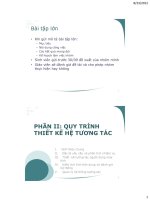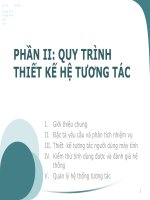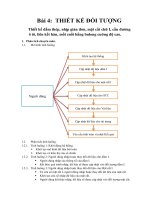The object oriented design process (THIẾT kế đối TƯỢNG SLIDE)
Bạn đang xem bản rút gọn của tài liệu. Xem và tải ngay bản đầy đủ của tài liệu tại đây (499.72 KB, 64 trang )
The Object-Oriented
Design Process
1
Topics
•
•
•
•
•
•
•
•
•
•
From Problem to Code
Identifying Classes
Identifying Responsibilities
Relationships Between Classes
Use Cases
CRC Cards
UML Class Diagrams
Sequence Diagrams
State Diagrams
Case Study: A Voice Mail System
2
From Problem to Code
• Three Phases:
– Analysis
– Design
– Implementation
3
Analysis Phase
• Establish the functions, services, and constraints of
the software to be developed.
– The developers and the software users work together to
produce a requirements specification, which will be the
input to the design phase.
• Functional Specification is a part of requirements
specification. It has the following characteristics:
– Completely defines tasks to be solved
– Free from internal contradictions
– Readable both by domain experts and software developers
– Reviewable by diverse interested parties
– Testable against reality
4
Design Phase
• Goals
– Identify classes
– Identify behavior of classes
– Identify relationships among classes
• Artifacts
–
–
–
–
Textual description of classes and key methods
Diagrams of class relationships
Diagrams of important usage scenarios
State diagrams for objects with rich state
5
Implementation Phase
• Implementation is the realization of the software
design in a specific programming language.
• Each unit (a single class) is implemented separately.
• Unit testing is done to ensure that each unit
functions properly with respect to its specification
before the units are integrated.
• The individual units are integrated and tested as a
whole to ensure that the entire software system
works properly conforming to its specification.
6
Case Study: Voice Mail System
• Program that simulates a telephone voice mail
system
• The system has a collection of mailboxes, each of
which may be accessed by an extension number
• Use text for voice, phone keys, hangup
• 1 2 ... 0 # on a single line means key
• H on a single line means "hang up"
• All other inputs mean voice
• In GUI program, will use buttons for keys
7
Identifying Classes
• Rule of thumb: Look for nouns in problem
description
–
–
–
–
–
–
Mailbox
Message
User
Passcode
Extension
Menu
• Focus on concepts, not implementation
– MessageQueue stores messages
– Don't worry yet how the queue is implemented
8
Categories of Classes
• Tangible Things
• Agents
• Events and Transactions
• Users and Roles
• Systems
• System interfaces and devices
• Foundational Classes
9
Identifying Responsibilities
• Rule of thumb: Look for verbs in problem
description
• An example: Behavior of MessageQueue:
– Add message to tail
– Remove message from head
– Test whether queue is empty
• OO Principle: Every operation is the responsibility of
a single class
– Example: Add message to mailbox
– Who is responsible: Message or Mailbox?
10
Identifying Class Relationships
• The following relationships can exist among classes:
– Dependency ("uses")
– Association, including aggregation and composition
– Generalization, including inheritance and implementation
• Among them, inheritance ("is-a"), aggregation
("has"), and dependency ("use") are the most basic
relationships
11
Dependency Relationship
• Class A depends on class B:
– A method of A manipulates objects of B in the parameters, local
variables, or return types
• Minimize dependency: reduce coupling
– Example: Removes dependence on System and Message
public class Message {
void print() {
public class Message {
String getText() {
// can print
System.out.println(text);
anywhere
Replace with
}
}
}
}
• UML notation for dependency
MailBox
MessageQueue
12
Association
• Association represents general binary relationships
between classes
• Association can have roles
• Implemented through instance fields
• An example and UML notation for association
relationship
Course
register for
has a participant
Student
13
Aggregation
• A special form of association
– Represents the has-a or part-whole relationship.
– Simply a structural relationship that distinguishes the
whole, that is, the aggregate class, from the parts, that is,
the component class.
– Implemented through instance fields
• e.g. MessageQueue aggregates Messages
• e.g. Mailbox aggregates MessageQueue
• An example and UML notation for aggregation
MessageQueue
Message
14
Composition
• A stronger form of aggregation
– The aggregate class exclusively owns the component
class.
– The lifetime of the components is entirely included in the
lifetime of the aggregate.
– Contained objects don't exist outside container
• An example and UML notation for composition:
message queues permanently contained in mail box
MailBox
MessageQueue
15
Association Direction
• Some associations are bidirectional
– Can navigate from either class to the other
– e.g. Course has set of students, student has set of courses
• Some associations are directed
– Navigation is unidirectional
– e.g. Message doesn't know about message queue
containing it
MessageQueue
0..*
Message
16
Multiplicities
• The number of instances one class relates to one
instance of another class.
–
–
–
–
any number (0 or more): *
one or more: 1..*
zero or one: 0..1
exactly one: 1
• For example:
– For each instance of Professor, many Course Offerings
may be taught.
– For each instance of Course Offering, there may be either
one or zero Professor as the instructor.
Professor
0..1
*
CourseOffering
instructor
17
Multiplicities
Implementation:
• 1, 0..1 relationship:
public class Mailbox {
...
private MessageQueue
queue;
}
MailBox
-...
-queue: MessageQueue
MessageQueue
•
MessageQueue
*
Message
-messages: List<Message>
public class MessageQueue {
*, 1..*
...relationship:
private List<Message>
messages;
}
18
Generalization - Inheritance relationship
• Inheritance relationship is formed when a class (or
an interface) extends another class (or interface).
• UML notation for generalization
SuperClass
<<interface>>
SuperInterface
SubClass
<<interface>>
SubInterface
19
Generalization - implementation relation
• The implementation relation between a class and an
interface
• Interface type describes a set of methods.
No implementation, no state
<<interface>>
Comparable
• Class implements interface
if it implements its methods
• UML notation for
implementation relation
Message
20
Use Cases
• Analysis technique
• Each use case focuses on a specific scenario
• Use case = sequence of actions
• Action = interaction between actor and computer
system
• Each action yields a result
• Each result has a value to one of the actors
• Use variations for exceptional situations
21
Use-Case Model
Actors
Các Use Case
...
Các đặc tả Use Case
(Use Case Specifications)
22
Sample Use Case
Leave a Message
1. Caller dials main number of voice mail system
2. System speaks prompt
Enter mailbox number followed by #
3. User types extension number
4. System speaks
You have reached mailbox xxxx.
Please leave a message now
5. Caller speaks message
6. Caller hangs up
7. System places message in mailbox
23
Sample Use Case -- Variations
• Variation #1
1.1. In step 3, user enters invalid extension number
1.2. Voice mail system speaks
You have typed an invalid mailbox number.
1.3. Continue with step 2.
• Variation #2
2.1. After step 4, caller hangs up instead of speaking
message
2.3. Voice mail system discards empty message
24
CRC Cards
• CRC = Classes, Responsibilities, Collaborators
– a very effective design tool in identifying classes, their
responsibilities, and relationships to other classes
• Developed by Beck and Cunningham
• Use an index card for each class
• Class name on top of card
• Responsibilities on left
• Collaborators on right
25









